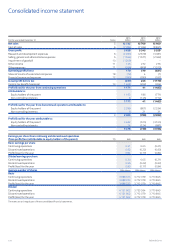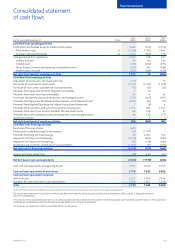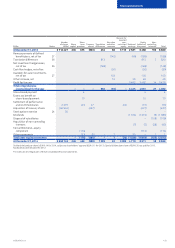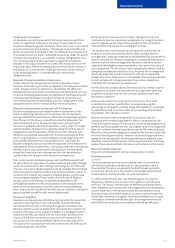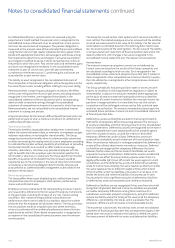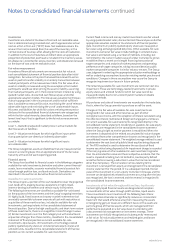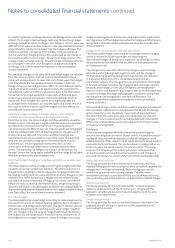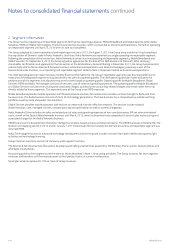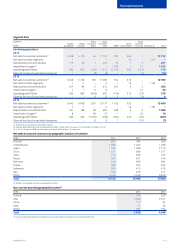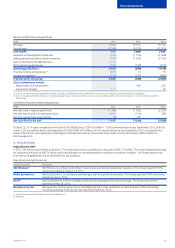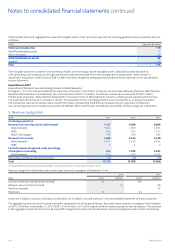Nokia 2014 Annual Report Download - page 136
Download and view the complete annual report
Please find page 136 of the 2014 Nokia annual report below. You can navigate through the pages in the report by either clicking on the pages listed below, or by using the keyword search tool below to find specific information within the annual report.134 NOKIA IN 2014
Inventories
Inventories are stated at the lower of cost and net realizable value.
Cost is determined using standard cost, which approximates actual
cost on a rst-in rst-out (“FIFO”) basis. Net realizable value is the
amount that can be realized from the sale of the inventory in the
normal course of business after allowing for the costs of realization.
In addition to the cost of materials and direct labor, an appropriate
proportion of production overhead is included in the inventory values.
An allowance is recorded for excess inventory and obsolescence based
on the lower of cost and net realizable value.
Fair value measurement
A number of nancial instruments are measured at fair value at
each consolidated statement of nancial position date after initial
recognition. Fair value is the price that would be received to sell an
asset or paid to transfer a liability in an orderly transaction between
market participants at the measurement date. The fair value of an
asset or a liability is measured using the assumptions that market
participants would use when pricing the asset or liability, assuming
that market participants act in their economic best interest by using
quoted market rates, discounted cash ow analyses and other
appropriate valuation models. The Group uses valuation techniques
that are appropriate in the circumstances and for which sucient
data is available to measure fair value, maximizing the use of relevant
observable inputs and minimizing the use of unobservable inputs.
All assets and liabilities for which fair values are being measured or
disclosed in the consolidated nancial statements are categorized
within the fair value hierarchy, described as follows, based on the
lowest level input that is signicant to the fair value measurement
as a whole:
Level 1—Quoted (unadjusted) market prices in active markets for
identical assets or liabilities
Level 2—Valuation techniques for which significant inputs other
than quoted prices are directly or indirectly observable
Level 3—Valuation techniques for which significant inputs
are unobservable.
The Group categorizes assets and liabilities that are measured at fair
value on a recurring basis into an appropriate level of the fair value
hierarchy at the end of each reporting period.
Financial assets
The Group has classied its nancial assets in the following categories:
available-for-sale investments, derivative and other current nancial
assets, loans receivable, accounts receivable, nancial assets at fair
value through prot or loss, and bank and cash. Derivatives are
described in the section on derivative nancial instruments.
Available-for-sale investments
The Group invests a portion of the cash needed to cover the projected
cash needs of its ongoing business operations in highly liquid,
interest-bearing investments and certain equity instruments.
The following investments are classied as available-for-sale based
on the purpose of the investment and the Group’s ongoing intentions:
(1) highly liquid, xed income and money-market investments that
are readily convertible to known amounts of cash with maturities at
acquisition of three months or less, included in available-for-sale
investments, cash equivalents in the consolidated statement of
nancial position. Due to the high credit quality and short-term nature
of these investments, there is an insignicant risk of change in value.
(2) Similar investments as in the rst category but with maturities at
acquisition of longer than three months, classied in the consolidated
statement of nancial position as current available-for-sale
investments, liquid assets. (3) Investments in technology-related
publicly quoted equity shares or unlisted private equity shares and
unlisted funds, classied in the consolidated statement of nancial
position as non-current available-for-sale investments.
Current xed income and money-market investments are fair valued
by using quoted market rates, discounted cash ow analyses and other
appropriate valuation models at the statement of nancial position
date. Investments in publicly quoted equity shares are measured at
fair value using exchange quoted bid prices. Other available-for-sale
investments carried at fair value include holdings in unlisted shares.
Fair value is estimated using a number of methods, including, but
not limited to: the current market value of similar instruments; prices
established from a recent arm’s length nancing transaction of
target companies; and analysis of market prospects and operating
performance of target companies, taking into consideration public
market comparable companies in similar industry sectors. The Group
uses judgment in selecting the appropriate valuation methodology as
well as underlying assumptions based on existing market practice and
conditions. Changes in these assumptions may cause the Group to
recognize impairments or losses in future periods.
The remaining available-for-sale investments are carried at cost less
impairment. These are technology-related investments in private
equity shares and unlisted funds for which fair value cannot be
measured reliably due to non-existent public markets or reliable
valuation methods.
All purchases and sales of investments are recorded on the trade date,
that is, when the Group commits to purchase or sell the asset.
Changes in the fair value of available-for-sale investments are
recognized in fair value and other reserves as part of other
comprehensive income, with the exception of interest calculated using
the eective interest method and foreign exchange gains and losses
on current available-for-sale investments recognized directly in the
consolidated income statement. Dividends on available-for-sale equity
instruments are recognized in the consolidated income statement
when the Group’s right to receive payment is established. When the
investment is disposed of, the related accumulated fair value changes
are released from other comprehensive income and recognized in the
consolidated income statement. The weighted average method is used
to determine the cost basis of publicly listed equities being disposed
of. The FIFO method is used to determine the cost basis of xed
income securities being disposed of. An impairment charge is recorded
if the carrying amount of an available-for-sale investment is greater
than the estimated fair value and there is objective evidence that the
asset is impaired including, but not limited to, counterparty default
and other factors causing a reduction in value that can be considered
other than temporary. The cumulative net loss relating to the
investment is removed from equity and recognized in the consolidated
income statement for the period. If, in a subsequent period, the fair
value of the investment in a non-equity instrument increases and the
increase can be objectively related to an event occurring after the loss
was recognized, the loss is reversed and the reversal is recognized in
the consolidated income statement.
Investments at fair value through prot and loss, liquid assets
Certain highly liquid nancial assets are designated at inception
as investments at fair value through prot and loss, liquid assets.
These investments must meet one of the following two criteria:
the designation eliminates or signicantly reduces an inconsistent
treatment that would otherwise arise from measuring the assets
or recognizing gains or losses on a dierent basis; or the assets are
part of a group of nancial assets, which are managed and their
performance evaluated on a fair value basis in accordance with
a documented risk management or investment strategy. These
investments are initially recognized and subsequently remeasured
at fair value. Fair value adjustments and realized gains and losses
are recognized in the consolidated income statement.
Notes to consolidated nancial statements continued


